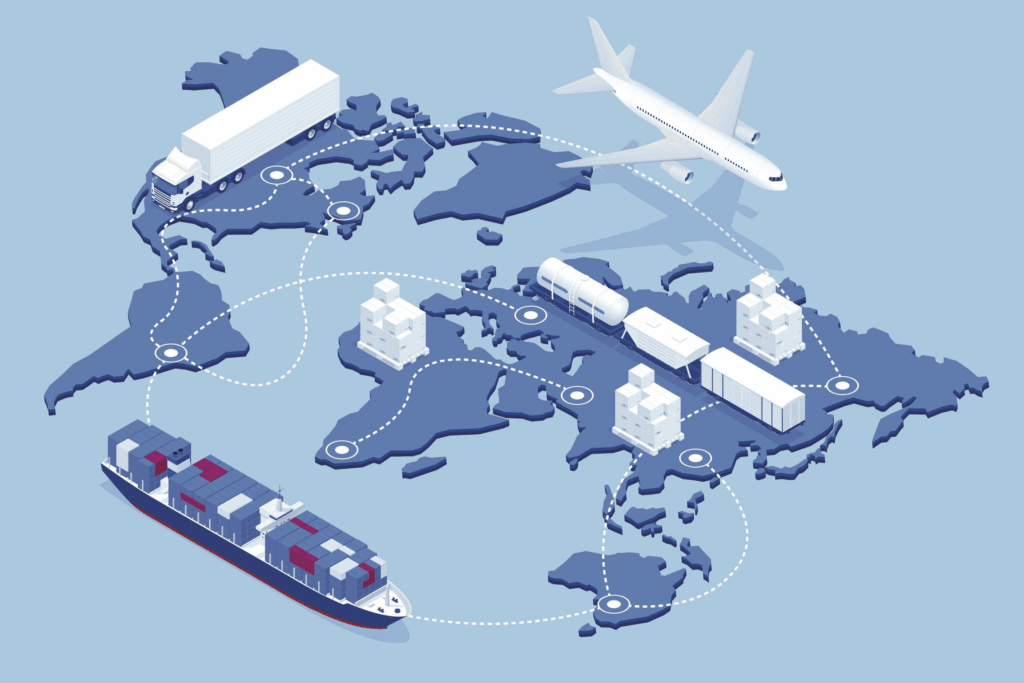Technology Trends in E-commerce Supply Chains: Automation, AI, and Speed
E-commerce supply chains are evolving rapidly to meet new challenges. With online shopping on the rise, consumers now expect faster delivery, real-time tracking, and hassle-free returns. To keep up, online businesses are turning to advanced technologies like automation, AI, and speed-focused logistics systems.
Tools like smart inventory forecasting and automated warehouses are not just future ideas—they’re already in use. This article looks at how these technologies are changing e-commerce logistics and how businesses can use them to stay ahead.

1. Automation: Eliminating Manual Bottlenecks
Manual tasks in order processing, inventory updates, or warehouse operations have long been a bottleneck in fulfillment workflows. Supply chain automation is revolutionizing e-commerce businesses’ operations by reducing human error, increasing speed, and improving consistency.
Key Innovations:
- Automated warehouses with robotics for picking, packing, and sorting
- Barcode and RFID scanning for real-time inventory accuracy
- Automated shipping label generation and carrier selection
- Self-service kiosks and lockers for last-mile delivery and returns
With automation, businesses can fulfill more orders in less time while scaling operations without proportionally increasing labor costs.
PostalParcel, for example, integrates automated label printing, multi-warehouse stock allocation, and return processing—all in a single platform—helping brands grow without growing overhead.
2. AI and Machine Learning: Smarter, Data-Driven Decisions

Artificial Intelligence (AI) is not just a buzzword—it’s becoming the brain behind smart supply chains. From demand forecasting to route optimization, AI and machine learning (ML) tools enable logistics providers to make faster, more accurate decisions.
Applications of AI in E-commerce Logistics:
- Predictive inventory: AI forecasts future demand based on historical sales, seasonal trends, and external variables like weather or holidays. This prevents overstock and stockouts.
- Smart warehouse allocation: AI can determine where to store inventory to minimize shipping time and cost based on customer geolocation data.
- Dynamic pricing for shipping: AI tools calculate real-time shipping costs based on volume, weight, delivery zones, and carrier capacity.
- Chatbots and virtual assistants: AI-powered tools improve customer service by automatically handling WISMO inquiries and return requests.
Companies using AI-enhanced OMS (Order Management Systems) and WMS (Warehouse Management Systems) are gaining a competitive edge by reducing latency and responding proactively to logistical challenges.
3. Speed: The New Competitive Currency

Speed is now a core component of the customer experience. Thanks to giants like Amazon, next-day—or even same-day—delivery has become the expectation. To meet these demands, e-commerce supply chains must be built for agility and speed at every stage.
Strategies to Improve Fulfillment Speed:
- Decentralized warehouse networks: Businesses can reduce last-mile delivery time by placing inventory closer to major customer regions.
- Micro-fulfillment centers (MFCs): Compact, automated hubs located in urban areas allow same-day delivery for high-demand SKUs.
- Carrier performance monitoring: Real-time insights into courier performance enable faster route switching when delays are detected.
- Pre-kitting and batch processing: Pre-packing can dramatically reduce pick-and-pack time for DTC brands with predictable product bundles.
At PostalParcel, we help brands achieve faster fulfillment through strategic inventory placement, carrier automation, and real-time logistics visibility—without needing to build infrastructure from scratch.
4. Integration in AI-Driven E-commerce Logistics
A modern supply chain is a connected supply chain. Integration across platforms—from storefronts and marketplaces to carriers and customs systems—is essential for end-to-end visibility and efficiency.
Critical System Integrations:
- E-commerce platforms like Shopify, WooCommerce
- Marketplaces like Amazon, Etsy, and Kickstarter
- Shipping carriers like USPS, DHL, Evri, Royal Mail, and CTT
- 3PL and 4PL warehouses for regional fulfillment
- Customs and compliance software to automate cross-border processes
PostalParcel’s unified dashboard connects all these systems, giving brands a single source of truth for orders, shipments, and returns across borders and regions.
5. Sustainability Meets Tech Efficiency

Tech innovation isn’t only about speed—it’s also about sustainability. More businesses are investing in green logistics powered by AI and automation to reduce waste and emissions.
Tech-Driven Sustainable Practices:
- Route optimization to lower fuel consumption
- Eco-friendly packaging automation that minimizes material usage
- Carbon offset tracking integrated into OMS dashboards
- Returns analytics to reduce product waste
Technology gives logistics providers the tools to not only meet customer demands but also operate in a more environmentally responsible way.
Conclusion
The future of e-commerce supply chains is built on automation, intelligence, and speed. Whether you’re a growing DTC brand or a global fulfillment provider, embracing these tech trends is essential for staying ahead in an increasingly competitive marketplace.
At PostalParcel, we combine smart OMS/WMS technologies, AI-driven decision-making, and automation to help brands confidently scale globally. From real-time tracking and warehouse automation to cross-border compliance and returns, our platform ensures you’re not just meeting customer expectations—you’re exceeding them.
Ready to future-proof your fulfillment strategy? Let PostalParcel help you harness the power of technology to streamline your e-commerce operations today.
Industry Insights
news via inbox
Nulla turp dis cursus. Integer liberos euismod pretium faucibua








